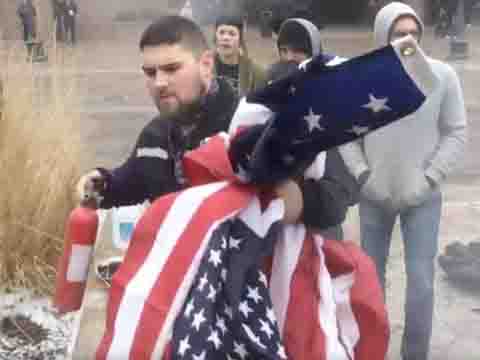Freedom to burn?
First Amendment rights debated after FedEx employee interrupts flag burning protest

FedEx driver Matt Uhrin walks away from the scene of the protest with the fire extinguisher and two saved flags in hand.
On Jan. 26, Matt Uhrin, a driver for FedEx, interrupted a riot near a pedestrian mall in Iowa City, Iowa. The small group of protesters were rebelling against the recently-enacted approval of the Dakota Access Pipeline, which was signed into effect by President Donald Trump on Jan. 24.
During this protest, two unidentifiable figures began to light two American flags on fire; it was at this point that Uhrin stepped in. Armed with a fire extinguisher, Uhrin appeared on the scene and took the flags one at a time from the hands of the protesters.
The video that depicts the action between the protesters and Uhrin went viral and could be viewed on a multitude of Facebook, Twitter and Snapchat feeds. While some called him a hero, others labeled him as a violation of freedom.
Uhrin spoke out about the event and the abundance of responses he’s gotten from the video in a local interview on Jan. 29. He stated his understanding that many people have offered to buy him a meal or send him gifts in return for his sacrifice of saving the flags. He asked that in place of this offering, they take their money and donate it towards groups that benefit service members and their families.
The Iowa resident has since made it clear that his intentions were pure and that he doesn’t want the praise he’s been receiving.
“The ones that are really the heroes are the ones that were injured, maimed, killed, the ones that never got to see home again. They’re the heroes,” Uhrin noted.
Some individuals began to question FedEx through Twitter on their intentions with the employee. The company has since commented on the matter through a tweet.
“We have reviewed the matter in Iowa City involving driver Matt Uhrin. He remains a FedEx employee [and] we have no plans to change his status,” FedEx tweeted early in the morning on Feb. 28.
The two that were shown burning the flags in the video have since been arrested for a misdemeanor in violating Iowa laws on open burning; however, there have been two different reactions to the event, and the other side defends themselves with the First Amendment claiming they have the right to burn the American flag.
To clarify, the Amendment itself states that, “Congress shall make no law respecting an establishment of religion, or prohibiting the free exercise thereof; or abridging the freedom of speech, or of the press; or the right of the people peaceably to assemble, and to petition the Government for a redress of grievances.”
This right has been debated for over a generation. After the protests in 2016 that consisted of kneeling during the National Anthem, individuals such as San Francisco 49er’s quarterback Colin Kaepernick have pushed their opinions out into the public spotlight.
“I want these things to change. I do know it will be a process, and it is not something that will change overnight. But I think there are some major changes that we can make that are very reasonable,” Kaepernick claimed as a reason for his silent protest.
To add a perspective that is able to speak on behalf of those that have sacrificed for the nation, some veterans backed claims such as Kaepernick’s by explaining that this was exactly the type of freedoms they have fought for. Others were baffled by the disrespect the protesters were showing and the entitlement they perceived they’ve felt.
In regards to the flag-burning riot that took place in January, many individuals have spoken out about the freedoms they have to protest their government, and inevitably their country, in any form that doesn’t place any other individuals in danger. On the other hand, many others have claimed that burning the flag is not a protest, which is classified as an “expression of objection,” but rather a purposeless sign of showing disrespect to the armed forces that provided them with their rights.
While interpretations of the First Amendment may never be clarified or agreed upon, the legality of the matters has since been brought up in recent political elections. Opinions on the length of coverage provided by the First Amendment are heavily debated throughout the federal courts.


